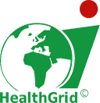 28 June - 1 July 2009, Berlin, Germany.
28 June - 1 July 2009, Berlin, Germany.HealthGrid 2009 is the 7th annual conference dedicated to the transformation of biomedical research, education, and medical care through the application of Grid technologies. The goal of this conference is to promote awareness and use of Grid technologies in the biomedical sector by bringing together stakeholders and experts from a variety of disciplines. HealthGrid 2009 will bring into focus future challenges like cloud computing, self adaptive Grid systems, data privacy on the Grid and Grid sociology. On the application level the current efforts on Pharma Grids and Grids for Virtual Physiological Human (VPH) and epidemiological studies shall be illustrated.
The HealthGrid Association is an initiative that brings together people from a variety of disciplines to promote awareness and use of Grid technologies in the biomedical sector. The HealthGrid community emphasizes a strong relationship among the private sector, government agencies, clinicians, and researchers. These connections foster the integration of Grid practices and tools into the fields of biology, medicine, and health. While the short-term goal of HealthGrid is to increase awareness of the power of grid technologies, the worldwide use of healthgrids is the ultimate aim.
The conference program of the seventh HealthGrid conference will include a number of high profile keynote presentations, complemented by a set of refereed papers, which will be selected through the present call for papers. In addition to papers, poster and demonstration sessions will also be selected through this call.
Paper Topics
A: ACCESSIBILITY
- The challenge of making Grid more accessible to bio-medical users
- Usability: ready -to -run Health-Grids?
- Grid technology versus web applications
- Data privacy: confi dentiality in distributed medical information systems and the security challenges
- Semantic techniques and the challenge of integrating hetero¬geneous biomedical data
- Visualization in Grids
- Next generation HealthGrids: self adaptive systems
- HealthGrids for genetics and epidemiological studies
- PharmaGrids: supporting phar¬ma research on grids
- Grid computing and the Virtual Physiological Human (VPH)
- Grid business aspects: sustainability and go-to-market strategies
- Experiences on production Grid used in real business
- Grid sociology: how to win society for Grids?
- Cloud computing, on-demand computing
- New demands beyond technology?
- Demonstrators for HealthGrid at Work
Important Dates:
Full paper - 1 February 2009
Author notification - 1 March 2009
Information for authors
Contributions can be made as full research papers (up to 5,000 words in length and maximum 10 pages) and/or as demonstrations. Selection for oral or poster presentation will be based on the content of the submitted papers, the originality of their contribution, technical quality, style and clarity of presentation, and importance to the fi eld. All papers must be submitted electronically. Please refer to the conference website for upload instructions.
All selected papers will be published in the book series "Studies in Health Technology and Informatics" published by IOS Press and referenced in PubMed (see http://www.iospress.nl/loadtop/load.php?isbn=shti). All conference participants will receive a complimentary copy of the articles on CD. The guidelines for authors and support tools are those of the series "Studies in Health Technology and Informatics" (see http://www.iospress.nl/authco/iospressbookarticle-word.zip).
For further information, please visit:
http://berlin2009.healthgrid.org/
Related news articles:
- Knowledge Base on healthgrids has been developed
- A roadmap towards a European HealthGrid
- Call for Papers HealthGrid 2007 in Geneva
About HealthGrid
HealthGrid is an initiative that gathers means and people from different backgrounds wanting to reach one goal: to reinforce and to promote awareness of the possibilities and advantages linked to the deployment of Grid technologies in the biomedical sector.
The concept of HealthGrid is to develop a strong relationship with clinicians and researchers to gain feedback in integration of grid use into health and apply them in the biomedical, medical and biological domains.
For further information, please visit http://www.healthgrid.org.